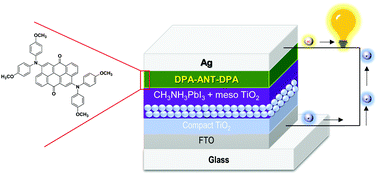当前位置:
X-MOL 学术
›
J. Mater. Chem. C
›
论文详情
Our official English website, www.x-mol.net, welcomes your feedback! (Note: you will need to create a separate account there.)
One step facile synthesis of a novel anthanthrone dye-based, dopant-free hole transporting material for efficient and stable perovskite solar cells†
Journal of Materials Chemistry C ( IF 6.4 ) Pub Date : 2017-12-18 00:00:00 , DOI: 10.1039/c7tc05238c Hong Duc Pham 1, 2, 3, 4, 5 , Kazuma Hayasake 6, 7, 8, 9 , Jinhyun Kim 10, 11, 12, 13 , Thu Trang Do 1, 2, 3, 4, 5 , Hiroyuki Matsui 6, 7, 8, 9 , Sergei Manzhos 14, 15, 16, 17 , Krishna Feron 5, 18, 19, 20, 21 , Shizuo Tokito 6, 7, 8, 9 , Trystan Watson 13, 22, 23, 24, 25 , Wing Chung Tsoi 13, 22, 23, 24, 25 , Nunzio Motta 1, 2, 3, 4, 5 , James R. Durrant 10, 11, 12, 13, 22 , Sagar Motilal Jain 13, 22, 23, 24, 25 , Prashant Sonar 1, 2, 3, 4, 5
Journal of Materials Chemistry C ( IF 6.4 ) Pub Date : 2017-12-18 00:00:00 , DOI: 10.1039/c7tc05238c Hong Duc Pham 1, 2, 3, 4, 5 , Kazuma Hayasake 6, 7, 8, 9 , Jinhyun Kim 10, 11, 12, 13 , Thu Trang Do 1, 2, 3, 4, 5 , Hiroyuki Matsui 6, 7, 8, 9 , Sergei Manzhos 14, 15, 16, 17 , Krishna Feron 5, 18, 19, 20, 21 , Shizuo Tokito 6, 7, 8, 9 , Trystan Watson 13, 22, 23, 24, 25 , Wing Chung Tsoi 13, 22, 23, 24, 25 , Nunzio Motta 1, 2, 3, 4, 5 , James R. Durrant 10, 11, 12, 13, 22 , Sagar Motilal Jain 13, 22, 23, 24, 25 , Prashant Sonar 1, 2, 3, 4, 5
Affiliation

|
Perovskite solar cell (PSCs) technology has made a tremendous impact in the solar cell community due to the exceptional performance of PSCs as the power conversion efficiency (PCE) surged to a world record of 22% within the last few years. Despite this high efficiency value, the commercialization of PSCs for large area applications at affordable prices is still pending due to the low stability of the devices under ambient atmospheric conditions and the very high cost of the hole transporting materials (HTMs) used as the charge transporting layer in these devices. To cope with these challenges, the use of cheap HTMs can play a dual role in terms of lowering the overall cost of perovskite technology as well as protecting the perovskite layer to achieve a higher stability. To achieve these goals, various new organic hole transporting materials (HTMs) have been proposed. In this study, we used a unique and novel anthanthrone (ANT) dye as a conjugated core building block and an affordable moiety to synthesize a new HTM. The commercially available dye was functionalized with an extended diphenylamine (DPA) end capping group. The newly developed HTM, named DPA–ANT–DPA, was synthesized in a single step and used successfully in mesoporous perovskite solar cell devices, achieving a PCE of 11.5% under 1 Sun condition with impressive stability. The obtained device efficiency is amongst the highest as compared to that of other D–A–D molecular design and low band gap devices. This kind of low cost HTM based on an inexpensive starting precursor, anthanthrone dye, paves the way for the economical and large-scale production of stable perovskite solar cells.
中文翻译:

一步一步合成新型基于蒽醌染料的无掺杂空穴传输材料,可实现高效,稳定的钙钛矿太阳能电池†
钙钛矿太阳能电池(PSC)技术在太阳能电池领域产生了巨大的影响,这是由于PSC的出色表现所致,在过去几年中,功率转换效率(PCE)飙升至22%的世界纪录。尽管具有如此高的效率值,但由于器件在环境大气条件下的稳定性低以及用作电荷传输的空穴传输材料(HTM)的成本很高,因此仍无法以可承受的价格实现大面积应用的PSC的商业化。这些设备中的层。为了应对这些挑战,廉价的HTM的使用在降低钙钛矿技术的总体成本以及保护钙钛矿层以实现更高的稳定性方面可以起到双重作用。为了实现这些目标,已经提出了各种新的有机空穴传输材料(HTM)。在这项研究中,我们使用了独特的新型蒽酮(ANT)染料作为共轭核心构件和可负担的部分来合成新的HTM。使用扩展的二苯胺(DPA)封端基团对可商购的染料进行功能化。新开发的HTM,名为DPA–ANT–DPA,一步一步合成,并成功用于介孔钙钛矿太阳能电池器件中,在1个太阳条件下的PCE达到11.5%,具有令人印象深刻的稳定性。与其他D–A–D分子设计和低带隙设备相比,所获得的设备效率是最高的。这种基于廉价的起始前体蒽醌染料的低成本HTM,
更新日期:2017-12-18
中文翻译:

一步一步合成新型基于蒽醌染料的无掺杂空穴传输材料,可实现高效,稳定的钙钛矿太阳能电池†
钙钛矿太阳能电池(PSC)技术在太阳能电池领域产生了巨大的影响,这是由于PSC的出色表现所致,在过去几年中,功率转换效率(PCE)飙升至22%的世界纪录。尽管具有如此高的效率值,但由于器件在环境大气条件下的稳定性低以及用作电荷传输的空穴传输材料(HTM)的成本很高,因此仍无法以可承受的价格实现大面积应用的PSC的商业化。这些设备中的层。为了应对这些挑战,廉价的HTM的使用在降低钙钛矿技术的总体成本以及保护钙钛矿层以实现更高的稳定性方面可以起到双重作用。为了实现这些目标,已经提出了各种新的有机空穴传输材料(HTM)。在这项研究中,我们使用了独特的新型蒽酮(ANT)染料作为共轭核心构件和可负担的部分来合成新的HTM。使用扩展的二苯胺(DPA)封端基团对可商购的染料进行功能化。新开发的HTM,名为DPA–ANT–DPA,一步一步合成,并成功用于介孔钙钛矿太阳能电池器件中,在1个太阳条件下的PCE达到11.5%,具有令人印象深刻的稳定性。与其他D–A–D分子设计和低带隙设备相比,所获得的设备效率是最高的。这种基于廉价的起始前体蒽醌染料的低成本HTM,



























 京公网安备 11010802027423号
京公网安备 11010802027423号